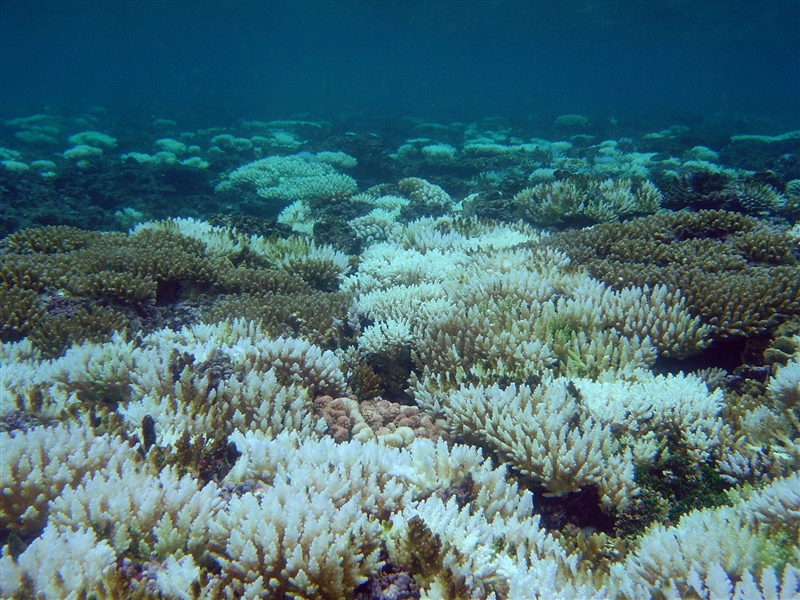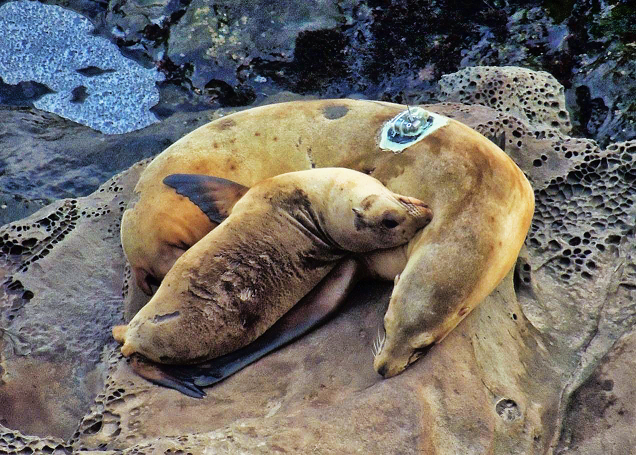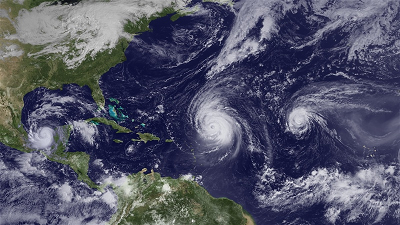Indicator Highlight: When the Ocean has Heat Exhaustion
- Anonymous
- |
- |
- 25 Comments
When you’re not feeling well, your body temperature can rise to alarming levels, indicating that something is wrong. If heat exhaustion continues to worsen and is left untreated, then the human body begins to shut down. What happens when the ocean has "heat exhaustion”? What would that look like and what would change?
Sea Surface Temperature (SST) is an indicator of ecosystem status and health similarly to how humans make an effort to combat an illness that increases their temperature to a harmful degree, coastal and ocean environments react to changes in SST. While we as humans may be able to remove layers or try to cool down with a cold compress, marine environments may not have the ability to regulate their temperatures - so what happens?
In humans, heat exhaustion is often accompanied by additional symptoms. When the ocean is warmer than normal, scientists have observed:
• Coral bleaching;
• Harmful algal blooms (HAB);
• Re-distribution of fish and marine mammals;
• Impacts to the food web;
• Larger and more frequent storms;
• Beach closures and other impacts to recreation;
• Changes to commercial and recreational fish availability, and more.
Keep reading to learn more about sea surface temperature, marine heatwaves, and why they’re important to track not just for marine resources, but for people too.
What is Sea Surface Temperature? What are Marine Heatwaves?
SST is the temperature of seawater near the ocean’s surface. SST, like air temperature, generally varies by latitude and changes seasonally; the closer to the equator the warmer and the more consistent the temperature over the seasons. SST measurements are important for climate and marine ecosystem monitoring and forecasting, marine mammal tracking, commercial fisheries management, and tourism.

When SSTs are abnormally high in a specific area for an extended period of time, it is known as a marine heatwave. We define marine heatwaves by a commonly used metric where temperatures greatly exceed normal values for five or more days in a row. Marine heatwaves can cause stress to many types of organisms in the affected area; thereby, changing the ecosystem by altering habitat, food webs, and species distributions.

In many parts of US waters, average SST and marine heatwave regularity and intensity are increasing.
Why do we track changes to Sea Surface Temperature and Marine Heatwaves?

We track SST and marine heatwaves because changes to their patterns and intensity can cause:
• Coral Bleaching: High temperatures threaten corals; when water is too warm, corals will expel the symbiotic algae (zooxanthellae)—which live in their tissues and create food—causing the coral to turn completely white. This is called coral bleaching. Corals can die from bleaching or from becoming vulnerable to other stressors like disease or pollution. NOAA forecasts coral bleaching using the Coral Reef Watch SST data product. Explore more data using the National Coral Reef Monitoring Program data visualization tool.
• Dangerous Toxins: HABs, which can be caused by high SSTs, occur when algae grow out of control and produce toxic or harmful effects on people, marine/aquatic organisms, and birds. (NOAA HABs; Learn more about Lake Erie HABs here).

• Re-distribution of marine animals: Changing temperatures can cause changes in where animals are present and alter migratory patterns of fish, birds, and marine mammals, which can mean fewer fish to catch, shortened fishing seasons, and a lack of food and habitat for marine mammals (Learn more here)

• Impacts to the food web: Research has shown that rising temperatures have affected the amount, type, and quality of food available to some species in the middle or top of the food chains, like California Sea Lions. These changes to the food web are related to National Marine Ecosystem Status indicators like chlorophyll-a, forage fish, and protected marine mammals. Learn more here and here.

How could Sea Surface Temperature and Marine Heatwaves affect me?
Warmer SST and more frequent marine heatwaves have noticeable impacts on our daily lives. For example, during Florida’s recent (2023) ocean heatwave, SST was as much as 5 degrees Fahrenheit above average and caused massive impacts on both marine organisms and humans. Over time, changes to SST and marine heatwaves could affect:
• The frequency and intensity of large, dangerous storms like hurricanes

• The quality of recreational activities like whale-watching or snorkeling
• How often you’re able to go to the beach due to closures, or consume shellfish/seafood due to toxicity. Higher temperatures promote the growth and toxicity of some harmful marine microbes that get into food sources or make swimming and beachgoing dangerous for humans and animals alike.
• The variety and prices of seafood available at the grocery store or local seafood market.
Though we often think about human-induced climate change as something that will happen in the future, it is an ongoing process. Increasing SST and marine heatwaves are becoming more common issues that will not just impact fish, marine mammals, and other ocean fauna in US Waters, but the people of the US too.
When you have heat exhaustion, you can take steps to try to improve your condition. When the ocean has is sick, we can all make an effort to try to work in general to reduce our climate impacts, build a more resilient system, and make it better. Learn more about climate change impacts and what you can do to help fight the ocean’s “sickness” at https://www.noaa.gov/education/resource-collections/climate/climate-change-impacts.
Read more:
The ongoing marine heat waves in U.S. waters, explained, NOAA
The Data Behind Our Warming Oceans, NOAA NCEI
NCEI Improves Analysis of Sea Surface Temperatures, NOAA NCEI
Study Finds Strong Marine Heatwaves in the Arctic, NOAA NCEI
ENSO Detection and Monitoring Depends on Data, NOAA NCEI
The Animal Telemetry Network, IOOS
NOAA, University of Queensland report: Marine heatwaves severely impacting corals
Coral reefs in peril in a record-breaking year, Science
Large Marine Heatwave Reaches Oregon and Washington Coasts, NOAA Fisheries